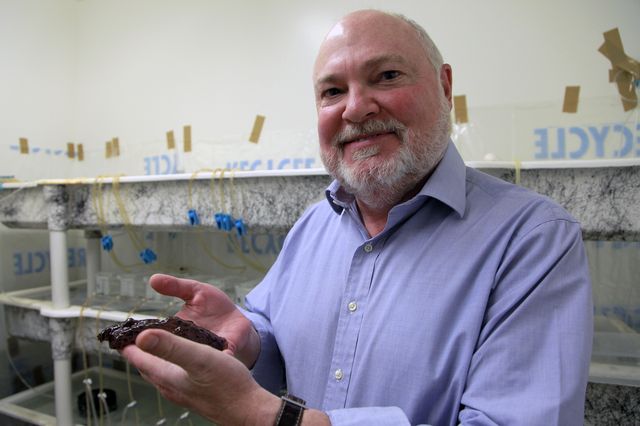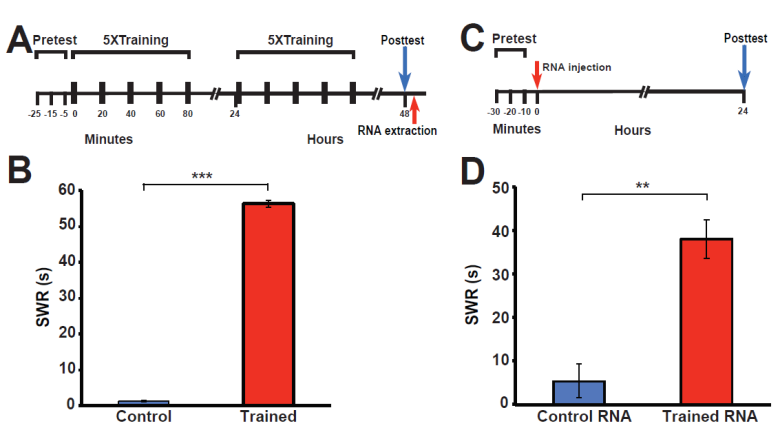Scientists have conducted an experiment on copying long-term memory in sea hares by injecting RNA

"I think in the long term, we may be able to use RNA injection to reduce Alzheimer's disease effects and post-traumatic rasstrostv", - says David Glantsman (David Glanzman), lead author Copy memories of marine birds, one of which is a biologist holding
is considered to be that long-term memory (LTM) in animals is encoded by changes in the strength of synaptic connections between neurons. The transmission of nerve impulses between cells is carried out chemically by means of mediators or electrically by passing ions from one cell to another, while during synaptic transmission the amplitude and frequency of the signal can be regulated.
But there is an alternative version that LTM is encoded by epigenetic changes. In this case, non-coding RNAs can serve as an intermediary for epigenetic changes. This version is considered alternative, because so far little empirical data has been collected in its favor.
Well, now the empirical data is obtained.
A group of scientists from the University of California at Los Angeles conducted a successful experiment on the transfer of long-term memories from aplizia - one of the largest representatives of the posteriorly brown mollusks, also called sea hares. The transfer of long-term memory is made by injecting RNA from a sensitized bearded rabbit to the others who have not previously experienced this experience. But with the help of an RNA injection, they “survived” it, that is, they got identical memories.
During the experiment, sea hares were beaten with a weak electric current in the tail area. The hares received five electrical discharges, once every 20 minutes, and then another five with an interval of 24 hours. Electrical discharges enhanced the hare's defensive reflex, which he displays to protect against potential harm. When the snails were subsequently tapped, the current shocks were reduced to protect for about 50 seconds — this is a type of training known as sensitization. Those who did not receive an electric shock were reduced by just one second.
Biologists have extracted RNA from the nervous system of trained bearded hares, as well as from those who have not been hit. Then, RNA from the first (sensitized) group was administered to seven hares who did not receive any blows, and RNA from the second group was introduced to representatives of the control group of seven other snails, who also did not receive any blows.
Scientists have discovered that the seven hares that received RNA from trained snails behaved as if they themselves had experienced this experience: the defensive contraction lasted on average about 40 seconds. As expected, there was no long-term reduction in the control group of snails.

“If long-term memory were stored at synapses, our experiment would not work,” Glantsman explained and added that the sea hare is an excellent model for studying the brain and memory, because scientists have studied the cellular biology of this simple animal form, which traditionally put experiences The cellular and molecular processes of the sea hare are very similar to human, although it has about 20,000 neurons in the central nervous system, and about 100 billion neurons in humans.
Now, scientists have proven that the specific cellular change underlying sensitization in marine hares (excessive excitability of the sensory neuron) can be replicated by affecting RNA sensory neurons from trained animals. These results provide evidence to support a non-synaptic, epigenetic memory model in saltwater hares.
Knowing the mechanisms of long-term memory formation is very important for the development of more effective learning models. If long-term memory is actually programmed by exposure to RNA from a trained animal, then more effective training models can be created.
Instead of learning thousands of objects, you can train a single animal, then take RNA from it and inject all the other animals that need to transfer the relevant experience to long-term memory.
In addition, the technique opens up a field for experiments on "erasing" unnecessary traumatic memories from long-term memory. For example, if they bring pain and suffering to an animal or cause its inappropriate behavior, as in the case of learned helplessness . Thus, it is possible to effectively “reprogram” the behavior of a living being for its own good. Naturally, memories of the fact of reprogramming can also be erased.
Scientific article published May 14, 2018 in the journal eNeuro(doi: 10.1523 / ENEURO.0038-18.2018, pdf ).
